Impact of Updraft on Neutralized Charge Rate by Lightning in Thunderstorms:A Simulation Case Study
WANG Fei(王飛),ZHANG Yijun(張義軍),and ZHENG Dong(鄭棟)
1 State Key Laboratory of Severe Weather,Chinese Academy of Meteorological Sciences (CAMS),Beijing 100081
2 Laboratory of Lightning Physics and Protection Engineering,CAMS,Beijing 100081
Impact of Updraft on Neutralized Charge Rate by Lightning in Thunderstorms:A Simulation Case Study
WANG Fei1,2*(王飛),ZHANG Yijun1,2(張義軍),and ZHENG Dong1,2(鄭棟)
1 State Key Laboratory of Severe Weather,Chinese Academy of Meteorological Sciences (CAMS),Beijing 100081
2 Laboratory of Lightning Physics and Protection Engineering,CAMS,Beijing 100081
The rate of neutralized charge by lightning(RNCL)is an important parameter indicating the intensity of lightning activity.The total charging rate(CR),the CR of one kind of polarity(e.g.,negative)charge (CROP),and the outflow rate of charge on precipitation(ORCP)are proposed as key factors impacting RNCL,based on the principle of conservation of one kind of polarity charge in a thunderstorm.In this paper,the impacts of updraft on CR and CROP are analyzed by using a 3D cloud resolution model for a strong storm that occurred in Beijing on 6 september 2008.The results show that updraft both promotes and inhibits RNCL at the same time.(1)Updraft always has a positive influence on CR.The correlation coefficient between the updraft volume and CR can reach 0.96.Strengthening of the updraft facilitates strengthening of RNCL through this positive influence.(2)Strengthening of the updraft also promotes reinforcement of CROP.The correlation coefficient between the updraft volume and CROP is high(about 0.9),but this promotion restrains the strengthening of RNCL because the strengthening of CROP will,most of the time,inhibit the increasing of RNCL.(3)Additionally,increasing of ORCP depresses the strengthening of RNCL.In terms of magnitude,the peak of ORCP is equal to the peak of CR.Because precipitation mainly appears after the lightning activity finishes,the depression effect of ORCP on RNCL can be ignored during the active lightning period.
lightning activity,updraft,neutralized charge,charging rate,charge amount
1.Introduction
Lightning activity is an important phenomenon of strong convective systems,and has a close relationship with observed atmospheric convection.For example,many researchers have found that the radar echo top of a thunderstorm is related to the lightning rate(Shackford,1960;Jacobson and Krider,1976; Williams,1985).Based on this correlation,Price and Rind(1992)established a parameterized scheme between the cloud top and lightning rate in a global numerical model.Also,the lifting condensation level (LCL)is found to have a very high correlation with the log value of the lightning rate(Williams et al.,2005; Fuchs et al.,2014),and the combination of dry bulb temperature and convective available potential energy (CAPE)has an evident correlation with the lightning rate,although the correlation coefficient is not very high(Fuchs et al.,2014).Williams and Stanfill(2002) found that high frequency lightning activity tended to be observed in thunderstorms with high LCL and moderate CAPE,rather than in thunderstorms with high CAPE and low LCL.
The above studies indicate that many parameters characterizing strong convection bear a relationship with lightning activity.In fact,most of these param-
eters directly reflect the characteristics of updraft.Observations have shown that the existence of a strong updraft in the mixed-phase region(–40–0℃)is necessary to produce lightning(Workman and Reynolds, 1949;Williams and Lhermitte,1983;Dye et al.,1988; Rutledge et al.,1992;Carey and Rutledge,1996;Petersen et al.,1996,1999;Pickering et al.,1998;Baker et al.,1999;Black and Hallett,1999;Wang et al., 2009;Heymsfield et al.,2010;Palucki et al.,2011;Yao et al.,2013;Zhang et al.,2013;Reinhart et al.,2014; Wang et al.,2015).Moreover,quantitative observational studies on the role of convective updrafts have been carried out.Lang and Rutledge(2002)reported that thunderstorms that predominantly produced positive cloud-to-ground lightning were accompanied by a large area of strong updraft(with speed>20 m s?1).Tessendorf et al.(2005)and Wiens et al.(2005) found a good correlation between the updraft volume with speed exceeding 10 m s?1and lightning activity.Deierling and Petersen(2008)found that updraft volumes above the–5℃isotherm,with vertical velocities greater than 5 and 10 m s?1,were well correlated with mean total lightning activity;the correlation coefficients were 0.93 and 0.92,respectively.They also indicated that the relationship between updraft volume and total lightning activity varied as a function of temperature and,depending on the temperature,also with region.Barthe et al.(2010)also found that the maximum updraft speed correlated well with lightning frequency only in thunderstorms with a very strong updraft.
Although the close relationship between updraft and lightning activity has been confirmed by many studies,it is still not clear as to the mechanism through which updraft affects lightning activity. Much research has focused on the impact of updraft on the charging process,while other studies have also indicated that updraft should have an evident influence on the discharging process(Zhang et al.,1999,2003; Miller et al.,2001).However,most of the work carried out on these two problems amounts to logical speculation based on observations,because of a lack of direct observations of updrafts and the charging process.Carey and Rutledge(1996)found that the volume and mass of graupel appearing in the upper part of a strong updraft correlated closely with the lightning rate,suggesting that updraft may affect the lightning frequency through its impact on the charging process occurring on graupel.Lang and Rutledge (2002)indicated that a strong updraft produced more super-cooled water and caused more collision and intensive charging between ice particles,resulting in the close relationship between updraft and lightning activity.Deierling and Petersen(2008)proposed that strengthening of the updraft produces more ice particles in the mixed-phase region,and thus a higher number of collisions with subsequent charge separation, which relate the updraft to the lightning frequency via positive correlation.They believed that the relationship between the updraft volume and lightning frequency is less regime-variant as the cold-cloud active precipitation-based charging zone is approached. Meanwhile,theoretical analysis has indicated that the updraft area—in particular,the area in the subfreezing layer of cloud—should be related to the generator current density,which in turn is linked to the electrical activity of the storm(Boccippio,2002).
Lightning frequency is,in many studies,taken to be the main parameter representative of the intensity of lightning activity.Usually,a thunderstorm with deeper convection will produce more frequent lightning activity(McCaul et al.,2009).However,recent observations have also revealed that the lightning frequency in a particular period is relative to the location of the deep convective updraft:lightning flashes tend to be smaller and more frequent in and near a strong updraft,and the flashes will show the opposite tendency when they are far away from the strong updraft(Carey et al.,2005;Kuhlman et al.,2009;Weiss et al.,2012; Bruning and MacGorman,2013).Recent research indicates that the flash length scales and flash areas are generally anti-correlated to the lightning flash rate (Mecikalski et al.,2015),reminding us that the lightning frequency cannot represent the characteristics of lightning activity intensity comprehensively.In this paper,we define RNCL,which is the charge neutralized by lightning flashes on the whole-thunderstorm scale in a specific period of time,to represent the in-
tensity of lightning activity.This parameter considers the effects of lightning frequency and flash scales comprehensively,and thus should be more appropriate for the lightning activity intensity.
Additionally,most previous studies support the positive influence of updraft on the charging process, and subsequently,the lightning activity. However, some researchers have also found that the relationship between updraft and lightning activity could sometimes vary,or be evident only under certain conditions (Deierling and Petersen,2008).This suggests that the impact of updraft on lightning activity is complex, and that present understanding is insufficient.Accordingly,the present study first aims to identify the main factors affecting RNCL,and then examine the relationships between updraft and these factors,such that the impact of updraft on RNCL can be analyzed comprehensively.This study is important not only for understanding the relationship between updraft and electrical activity in a thunderstorm,but also for furthering research progress on lightning activity.
2.Model and definitions
2.1Model
The model used here is a 3D cloud resolution model constructed firstly by Hu and He(1988),and then coupled with charging and discharging processes by Tan et al.(2006).The nonhydrostatic balance equation is adapted to construct the dynamic framework.The air is treated as a tack free and compressible fluid.Hydrometeors in clouds include five categories:cloud drop,ice crystal,rain drop,graupel,and hail.The sedimentation and the dragging force of all hydrometeors,except for cloud drop,are considered. Twenty seven kinds of cloud microphysical processes, such as evaporation-condensation,coagulation,automatic transformation,nucleation-multiplication,and melting-freezing,are simulated in the model.The initiation field of the model can be established based on sounding data.The convection is initiated by a damp and hot bubble,which is a restricted perturbation field with higher humidity and temperature than the environment added in the low level artificially,and developed according to the calculation result of buoyancy in the vertical motion equation.
Three charging schemes,including the noninductive charging process in the process of collision and rebound between graupel/hail and ice crystal(Gardiner et al.,1985;Pereyra et al.,2000;Tan et al.,2006),the inductive charging process between graupel/hail and cloud drop in the dry growth process(Ziegler et al,1991),and the charging process due to the surface temperature difference in the ice crystal multiplication process(Hallet and Saunders,1979), are used here to simulate the charging process in the thunderstorm.
In the discharging scheme,the electrical field threshold of lightning initiation was defined by Marshall et al.(1995)as a function of air density,which is related to height;the main points of the random discharging model proposed by Mansell et al.(2002)are adopted in the discharging scheme;and the propagation of positive and negative leaders and the inductive charge in the lightning channel are all calculated based on the concept of the bidirectional leader(Kasemir, 1960,2012).The lightning channel is treated as a good conductor with resistance when the electrical potential of a new grid of the lightning channel is calculated by using the formula:

where φiniis the reference potential,usually replaced by the environmental potential value;p is the polarity of charge in the channel;n is the number of path segments that the channel has propagated;is the inner electrical field in the channel,set to a constant of 500 V m?1;and diis the length of every path segment.After a new step of the lightning channel is finished,the distribution of the electric field outside the channel is recalculated.The inductive charge density within the channel,is calculated as follows:

where ε is the dielectric constant of air,and n indicates the normal direction of the conductor surface.When there is no probability for development of both ends
of the lightning channel,or either end of the channel reaches the border of the simulation domain,this simulated discharging process will stop.After a discharging process stops,all charges in the channel will be redistributed according to the proportion of surface area of hydrometeors within and near the channel(the original charge on the hydrometeors will be ignored). The redistribution formula(Ziegler and MacGorman, 1994;Mansell et al.,2002)is as follows:


The horizontal resolution and vertical resolution of the model are set to 1 and 0.5 km,respectively.The time step is 1 s,and the simulation time is set to 60 min.
2.2 Definitions
In the analysis,RNCL is the total charge neutralized by all lightning flashes in the thunderstorm, occurring within the specified time interval.CR is the total charge of one kind of polarity(e.g.,negative) of two polarities obtained by all kinds of hydrometeors in the thunderstorm,in the same time interval, through the non-inductive charging process,the inductive charging process,and the charging process in the ice crystal multiplication process.The total amount of one kind of polarity charge(TAOC)in the thunderstorm is the rest of TAOC in the thunderstorm after all lightning flashes in the time interval have finished, and CROP in the thunderstorm is the change between TAOC in the present time interval and TAOC in the previous interval.ORCP is the total charge of one kind of polarity(e.g.,negative)on the precipitation falling out of the thunderstorm in the time interval,and the precipitation is all hydrometeors that fall down to the height at or below 1 km.The updraft region is defined as the region where the vertical speed is upward and greater than 1 m s?1.
3.General case description
A series of strong convective systems occurred over Beijing from the night of 6 September to the morning of 7 September 2008.Based on the sounding at 1200 UTC 6 September in Beijing,a thunderstorm simulation was carried out by using the 3D charging-discharging cloud resolution model.The simulation results are shown in Fig.1.The first simulated lightning occurs at the 16th minute,and ends at the 31st minute. In total,the simulated lightning activity lasts for about 15 min.The simulated lightning frequency increases at first,before the 19th minute,when the frequency reaches its peak of 12 flash min?1,and then decreases(Fig.1a).The observation of the first thunderstorm cell of the system,based on on SAFIR3000,indicates the lightning frequency of
the thunderstorm at the first 15 minutes to be similar to the simulated lightning frequency.The observed lightning frequency also increases at first,and reaches its peak of 14 flash min?1at the 6th minute after the start of lighting activity.The observed peak value is very close to that value of the simulated lightning frequency.
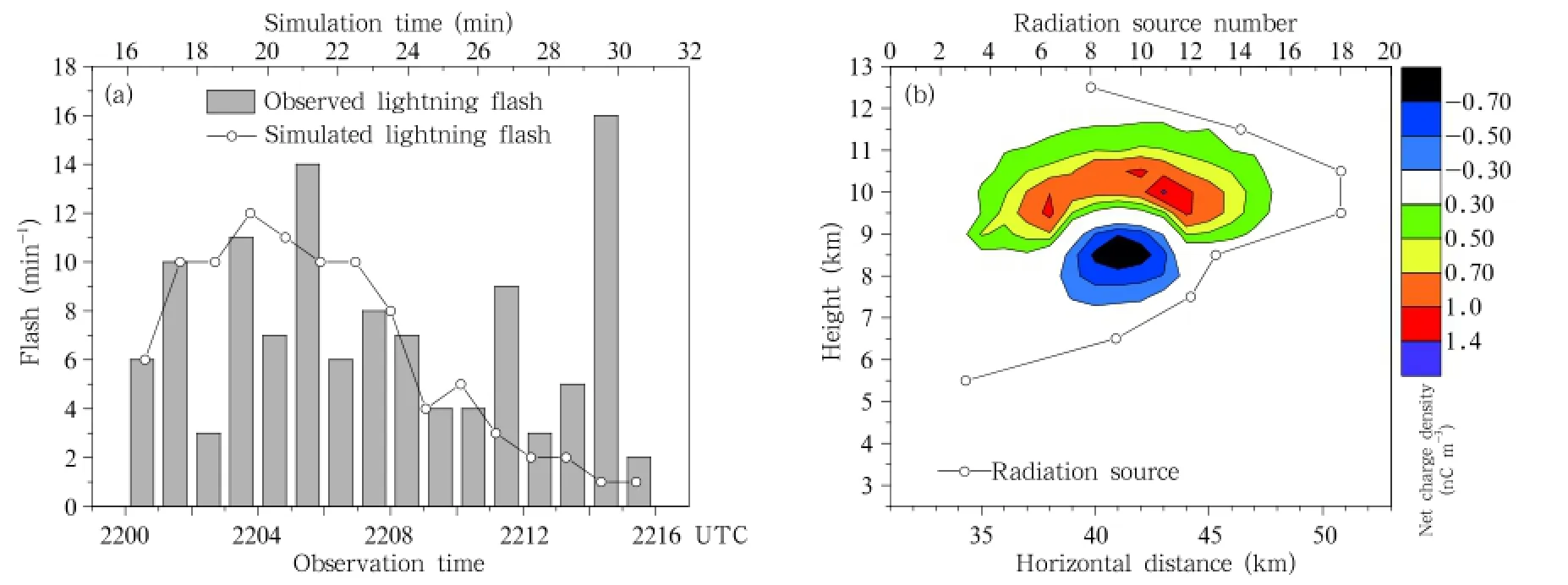
Fig.1.(a)Comparison between the observed and simulated lightning flash frequency and(b)charge structure(color scale)along the vertical profile of the positive charge center at the 24th minute,and the distribution(line)of the heights of lightning radiation.Sources from SAFIR3000.
According to the height distribution of the radiation sources of the lightning observed by SAFIR3000, the peak distribution range is from 9 to 11 km,which indicates the height of the main positive charge layer should also be located near the height of 9–11 km. Along the vertical profile of the simulated thunderstorm,together with the position of the maximum positive charge density when the simulated lighting frequency reaches its peak,the charge structure in the thunderstorm illustrates a dipolar structure,with the main positive charge layer above the main negative charge layer.The height range of the main positive charge layer is also from 9 to 11 km,which is the same as the height range of the main positive charge layer derived from the observation.
The comparisons above suggest that,in terms of the lighting frequency and charge structure,the simulated thunderstorm is very similar to the observed thunderstorm in the system.Therefore,the simulated results are considered credible and appropriate for further analysis.
In the simulated results,RNCL keeps increasing after lightning activity starts at the 13th minute. From the 23rd to 24th minutes,RNCL reaches a peak of about 408 C min?1;then,it decreases gradually until lightning activity ends at the 31st minute.
4.Simulation result analysis
From the perspective of microphysical processes, lightning is not only a simple neutralized charge process,but also a complex process of interaction with charge structure.In fact,lightning is a non-transient process.During the process,charge that is widely distributed in the thunderstorm(in spatial terms)mixes with charge deposited in the lightning channel through the processes of turbulent exchange,advection,gravity setting and charging.Part of the charge is neutralized,and part of the residual charge will participate in the reconstruction of the charge structure before the next lightning process begins(Tan et al.,2007).However,on larger spatial and longer temporal scales,the complexity of an individual lightning process can be neglected if the balance between the source and remit of the charge in the whole thunderstorm is considered; only the overall result of all lightning in the thunderstorm within a particular time interval can be shown. The source and remit of the charge with one kind of polarity in a thunderstorm should be balanced,as in the following formula:


4.1CR
The model used in this study includes three kinds of charging processes:the non-inductive charging process during the collision and rebound between graupel/hail and ice crystal(Gardiner et al.,1985);the inductive process between graupel/hail and cloud drop (Ziegler et al,1991);and the charging process during ice crystal multiplication(Hallett and Saunders, 1979).Although these three charging processes are only part of all charging processes in the thunderstorm,many studies have demonstrated that at least the first two charging processes are the main charging processes generating most of the charge in the thunderstorm.In particular,the non-inductive charging process considered here should be the most important charging process in the thunderstorm(Takahashi, 1978,1984).
The simulation verifies that the CR of the noninductive charging process during the lightning activity is considerably greater than the CRs of the inductive charging process and the ice crystal multiplication charging process(Fig.2a).The mean CR of the non-inductive charging process is about 6.54×109nC s?1,which is almost three times the mean CR of the inductive charging process.Even from the 17th to 20th minutes,the CR of the non-inductive charging process is one order of magnitude higher than the CR of the inductive charging process.The mean CR of the ice crystal multiplication charging process is the smallest;the magnitude is only 107nC s?1,which is much less than the first two CRs.This indicates that the CR of the non-inductive charging process is dominant,at least during the time of main lightning activity.Therefore,using the CR of the non-inductive charging process to represent the overall CR during lightning activity should be reasonable.
A comparison of the updraft volume and the CR of the non-inductive charging process is illustrated in Fig.2b.It reveals that they have a similar trend: before the 19th minute,they keep increasing.Then, after the 19th minute,both of them begin to decrease. Statistically,there is good correlation between them; the correlation coefficient is 0.87.This suggests that the updraft volume affects the intensity of the CR of the non-inductive charging process,which process is representative of the total CR in the thunderstorm during lightning activity.The positive correlation between the CR of the non-inductive charging process and the updraft volume reflects the fact that the CR as a whole is also positively correlated with the updraft volume.This result is coincident with many observations,in which researchers have found good correlation between the updraft volume and lightning frequency (Tessendorf et al.,2005;Wiens et al.,2005;Deierling and Petersen,2008;Barthe and Barth,2008;Barthe et al.,2010).
The spatial relationship between the region with the non-inductive charging process and the updraft (Fig.3)indicates that:(1)The main non-inductive charging process occurs in the top part of the updraft when the updraft is strong(Fig.3a);(2)The main non-inductive charging process still occurs near the top part of the updraft when the updraft begins to weaken and the vertical channel of the updraft becomes gradually inclined(Fig.3b).However,the region with the non-inductive charging process becomes wider and its center starts to deviate to the center of the updraft in the horizontal direction,although an obvious charging process still occurs around the core of the updraft;(3)The main non-inductive charging process still occurs over the region with weak updraft when the updraft weakens considerably(Fig.3c),and the region with the non-inductive charging process and the region with the updraft show evident separation in the horizontal direction;(4)When the updraft continues to weaken and the vertical channel of the updraft almost disappears,the region with the evident noninductive charging process also lessens until it disappears,but it is still distributed near the region with
a certain updraft speed(Figs.3d–f).
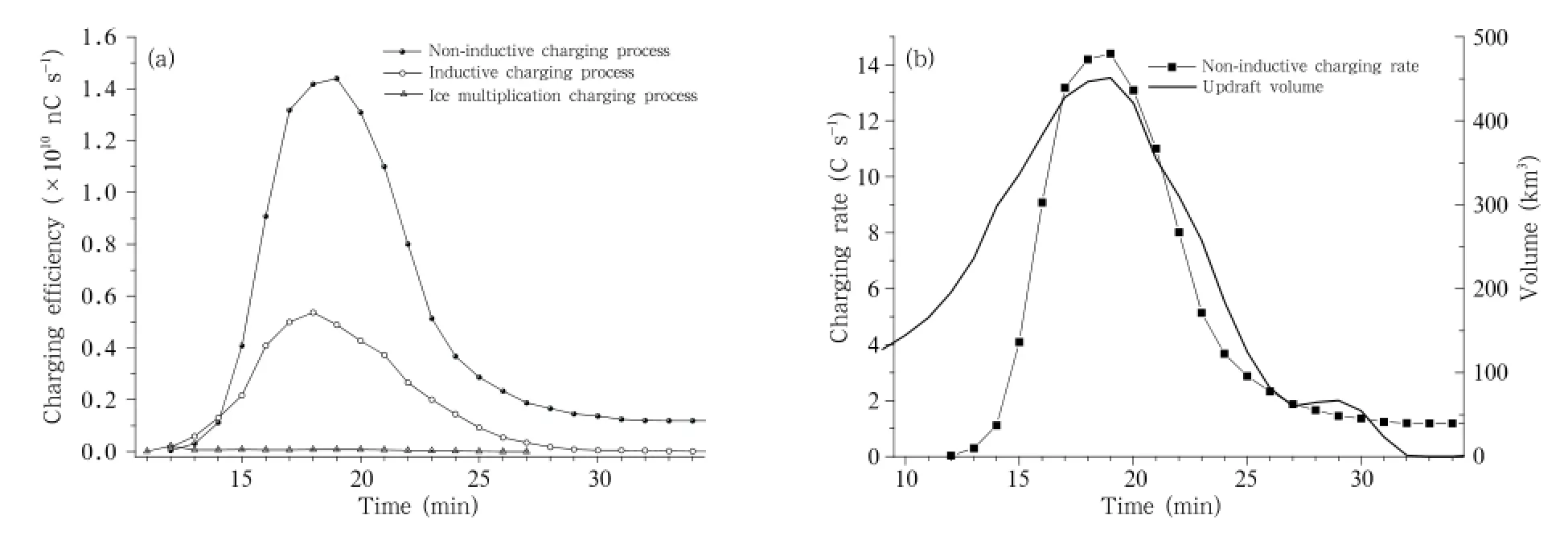
Fig.2.(a)Efficiencies of three types of charging mechanism and(b)evolution of the updraft volume and non-inductive charging rate.
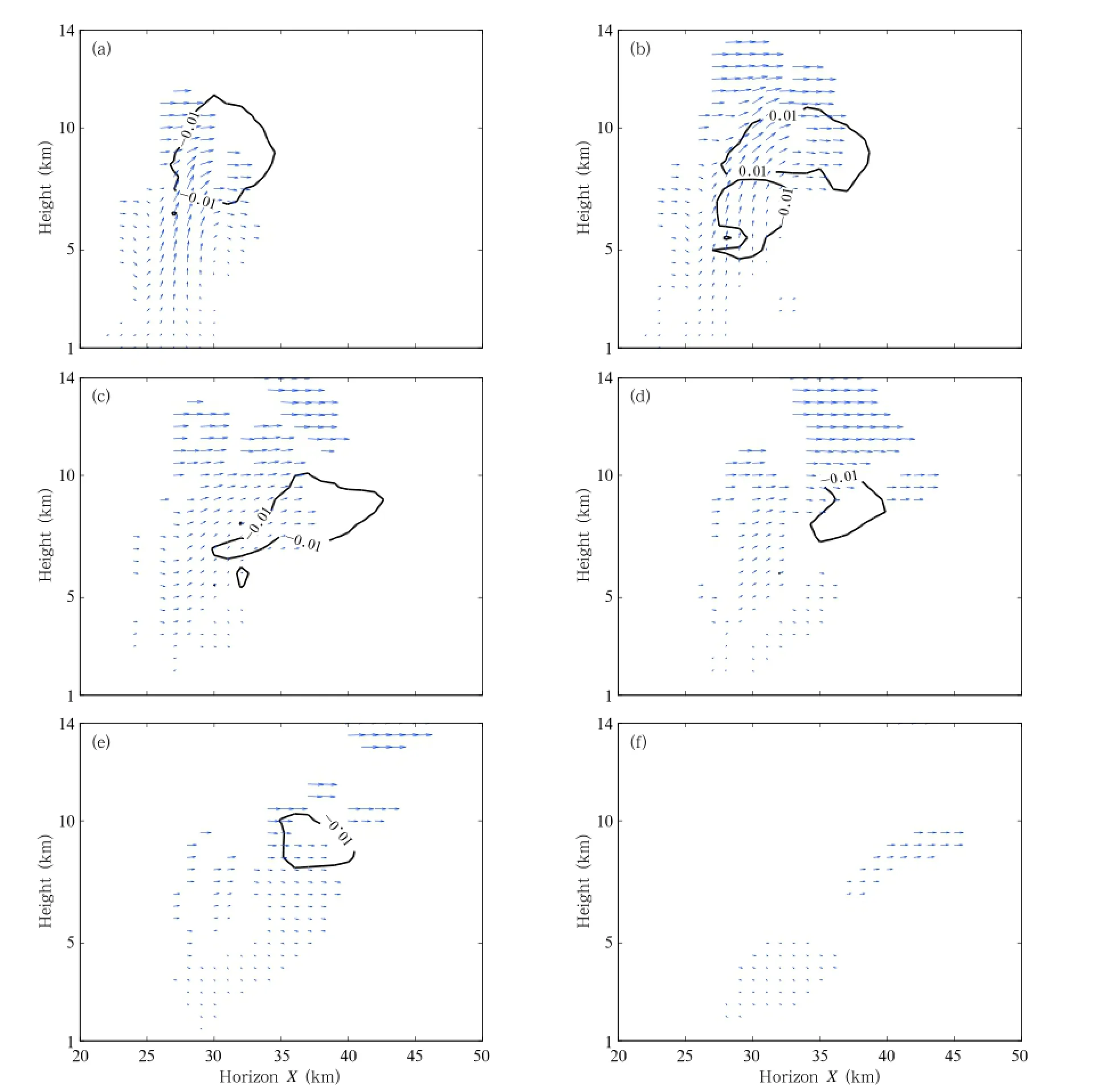
Fig.3.Charging rate(contours;absolute charging rate>0.01 nC m?3s?1)and wind field(vectors;only winds with speed greater than 1 m s?1are shown)in the profile of the non-inductive charging rate center at the(a)13th,(b)16th, (c)19th,(d)22nd,(e)25th,and(f)28th minute.
The region with the non-inductive charging process should bear a close relationship with the updraft region. Indeed,when a strong updraft exists,the main region with the non-inductive charging process is always located in and near the updraft region.Despite the evident updraft disappearing and the region with the non-inductive charging process not coinciding with the updraft region spatially,the non-inductive charging process nevertheless occurs near the region with weak updraft speed.This should be the reason that causes updraft to correlate well with the CR of the non-inductive charging process.This correlation should lead to a positive influence of updraft on the non-inductive charging process.
4.2CROP
The charging process on hydrometeors primarily occurs within and near the region of updraft. Charged hydrometeors are carried to a wider region
by air transport.This makes the distribution region of charge become wider and wider,and the process should bring about the relationship between updraft and CROP.
In the case of negative charge in the thunderstorm,the total amount of negative charge reaches a peak of–1.3×1012nC at the 21st minute,then begins to decrease,and the total amount keeps below 5 ×1011nC near the end of lightning activity(Fig.4a). The peak CROP for negative charge appears at the 16th minute and reaches about 5.5 C s?1.
As we know,the total amount of charge is decided by the volume and density.Here,0.1 and 1 nC m?3are chosen as criteria of charge density to discuss the relationship of charge density with TAOC and the volume.The comparisons between TAOC for negative charge and the volumes with the two kinds of negative charge density criteria show that the trend of TAOC is obviously consistent with the trend of the volume with high charge density(Fig.4):they reach a peak at the same time and correlate well(correlation coefficient: 0.93).The volume with low charge density keeps increasing,which is different to the change of TAOC.This suggests that CROP should have a closer relationship with the change of the volume with high charge density.

Fig.4.Evolution of the(a)total mass of negative charge on hydrometeors and(b)volumes with negative charge density on hydrometeors greater than 0.1 and 1 nC m?3.
Meanwhile,the spatial relationship between updraft and the distribution of hydrometeors with negative surface charge(Fig.5)shows that the first region with negative charge appears in the upper part of the updraft.The distribution region of negative charge firstly extends in the vertical direction,and then spreads horizontally along the outflow near the top of the updraft.When the updraft is strong enough (Figs.5a–d),the negative charge distribution region also changes evidently;when the evident updraft channel disappears(Figs.5e–j),the change in the negative charge distribution region is inconspicuous,and the main change is expressed via a change in shape and height.
A comparison between the volume with negative charge on hydrometeors and the volumes with updraft speeds greater than 1 and 5 m s?1shows that three curves have similar change if time is not taken into account(Fig.6).The volumes of both updrafts reach their peak earlier than the volume with negative charge on hydrometeors.This is reasonable because when the updraft begins to decrease,the region of hydrometeors with negative charge will keep expanding under the influence of the weakening updraft.Consequently,the peak time for the volume with negative charge on hydrometeors will arrive later than for the updraft volume.
These results suggest that CROP should have a close relationship with the change of updraft volume.Although they might not be synchronous,their changes are similar.This makes updraft have a positive impact on CROP.According to Eq.(5),the positive influence of updraft on CROP,(Qt+?t?Qt),will be offset by that on CR.This causes updraft to inhibit the strengthening of RNCL through its positive impact on CROP,although this inhibition should,most of the time,be weaker than the strengthening effect of updraft on RNCL through its impact on CR.
4.3ORCP
Besides the neutralization of lightning,the charge in a thunderstorm could be reduced through precipitation(referred to as cold cloud precipitation),discharge in the upper atmosphere,and so on.Most of these phenomena have been studied,but quantitative observation is rare,and theoretical studies are primarily in the exploration stage.Therefore,in this study,only
the reduction of charge through precipitation is analyzed.
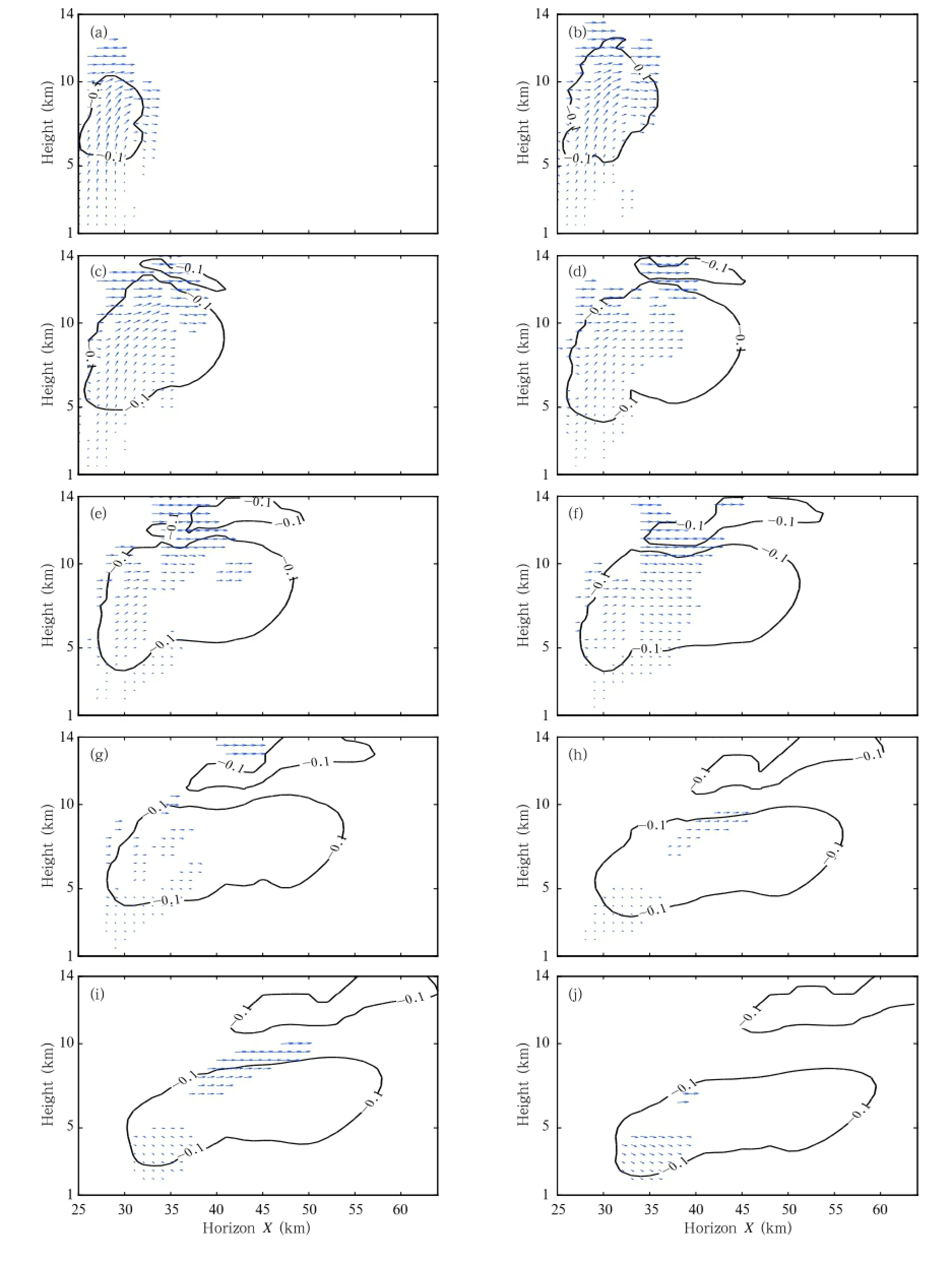
Fig.5.Profiles of negative charge on hydrometeors and updrafts at the(a)14th,(b)16th,(c)18th,(d)20th,(e)22nd, (f)24th,(g)26th,(h)28th,(i)30th,and(j)32nd minute.Lines indicate the contours of absolute charge density greater than 0.1 nC m?3.Vectors indicate the wind.
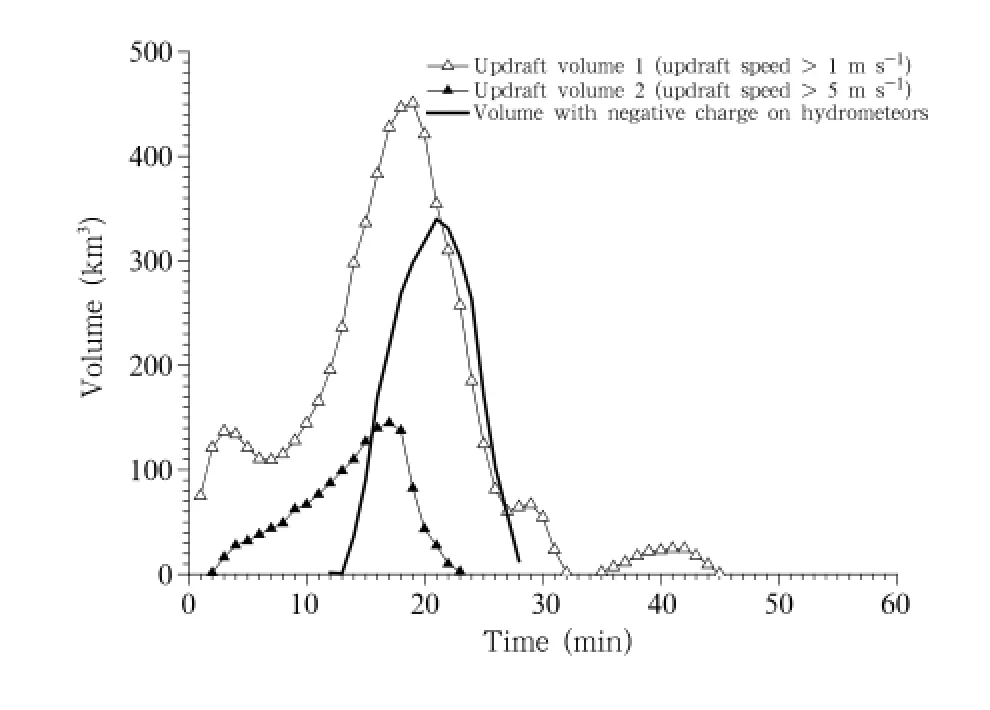
Fig.6.Evolutions of the updraft volumes for w>1 and w>5 m s?1,and the updraft volume with negative charge on hydrometeors.
In the case of negative charge in the thunderstorm,the magnitude of CR is the same as the magnitude of ORCP,and the maximum of ORCP is even slightly higher than that of CR(Fig.7).This indicates that the value of ORCP is significant.ORCP will severely weaken the promoting effect of CR on RNCL,and could even lead to a stop in lightning activity if they occur synchronously.However,in the thunderstorm simulated here,they are not synchronous. The main precipitation occurs after when the lightning activity finishes.During the lightning activity, CR has a significant advantage compared to ORCP.
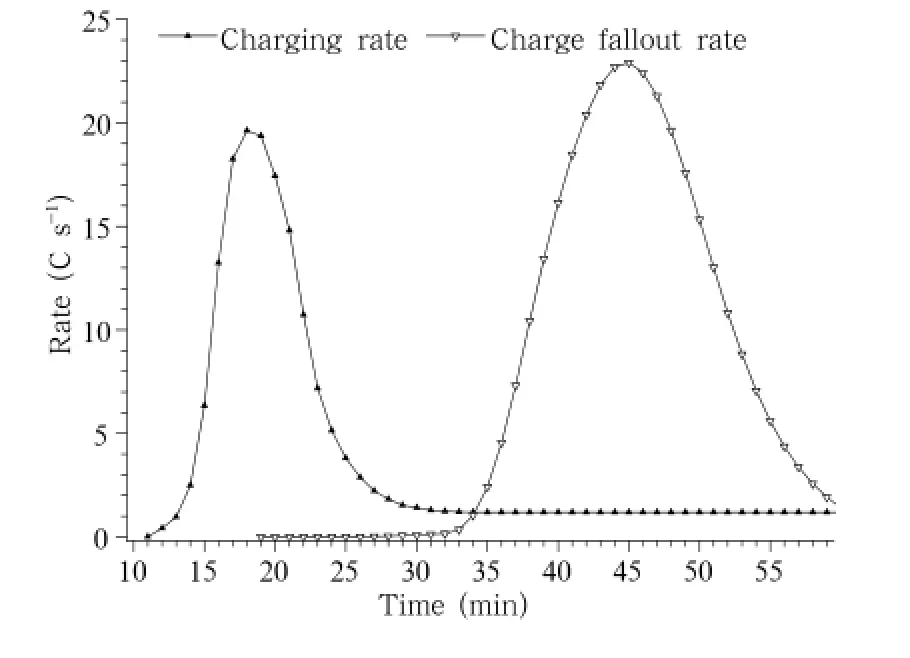
Fig.7.Evolutions of the charging rate by charging mechanisms in clouds and the charge fallout rate via precipitation.
The observation of the first thunderstorm shows that the precipitation was weak over a very long period during this thunderstorm.The automated rain gauge in Beijing recorded precipitation of several millimeters only during about 2 h after the first lightning was detected.After the lightning activity had lasted for nearly 2 h,the recorded precipitation began to increase evidently,and the maximum reached 168 mm h?1.The tendency of the most evident precipitation lagging behind the main lightning activity is consistent between the observation and simulation.Indeed,such non-synchronization between precipitation and lightning activity has also been found in many other observations(e.g.,Zheng et al.,2010).Liu and Zipser (2008)analyzed the diurnal variation of precipitation and lightning activity in different regions of the tropics using satellite data.They found that the peak time of lightning activity was asynchronous with the peak time of precipitation in four of five regions,based on simultaneous precipitation and lightning data.These observations suggest that,on the whole,the time with frequent lightning flashes may not overlap with the time of heavy precipitation.Therefore,the simulation result with respect to the temporal relationship between lightning activity and the main precipitation should be typical for most thunderstorms. Consequently,ORCP(Qout)could be negligible compared with CR(Qchar)during most of the lightning activity period.
From another point of view,it is conceivable that the non-synchronization of frequent lightning activity and heavy precipitation appears simply because the heavy ORCP seriously impairs the lightning activity.
4.4 Discussion of the overall effect
According to the above analysis,Eq.(5)could be simplified as follows for most of the lightning activity period:

The polynomial fitting of the updraft volume with CR(Qchar)and CROP(Qt+?t?Qt)is given separately in Fig.8.Note that in order to express the different contributions of CR and CROP intuitively, the negative value of CROP for negative charge shows the increasing of TAOC.As can be seen,they both
correlate well with the updraft volume;the correlation coefficients are 0.96 and 0.90,respectively.The trends of the fitting curves indicate that:(1)CR and CROP both have accelerated increases with increasing updraft volume;(2)CR keeps increasing as the updraft volume grows;(3)CROP increases with the growth of updraft volume only when the updraft volume is greater than 133 km3,and the value of CROP remains positive when the updraft volume is below 280 km3.This is because the volume and the mass of negative charge keep decreasing,although there is still a small region with weak updraft,while the updraft weakens considerably.Therefore,CROP is positive. However,when the updraft volume is greater than the threshold,CROP also increasingly accelerates.
A comparison between both of the accelerations shows that CR has higher acceleration than CROP with the growth in updraft volume.According to the fitting equations(Fig.8)and Eq.(6),RNCL(y1+y2), synthesizing the results of CR and CROP,also illustrates an increasing acceleration with the growth in updraft volume.The inhibition of updraft on lightning activity becomes relatively evident only when the updraft is sufficiently strong,e.g.,the updraft volume is greater than 280 km3.As the updraft volume becomes larger in Fig.8,so does the difference between y1and y1+y2.During the final period of lightning activity,CROP becomes positive,which reduces the decreasing speed of RNCL.
5.Conclusions
To improve understanding of the factors impacting upon lightning activity,and according to the principle of the balance between the source and remit of one kind of polarity charge on the whole-thunderstorm scale,this study proposes that there should be three factors affecting RNCL,which represents the intensity of lightning activity,from the macro perspective of the thunderstorm:CR,CROP,and ORCP.Based on a simulation by using a 3D cloud resolution model coupled with charging and discharging processes,the impact of updraft on CR and CROP was analyzed. The results show that:
1)Updraft has a positive influence on CR.The size of the region with the charging process is the key factor for CR.The main charging process always occurs within and near the updraft region.This causes a positive correlation between the updraft volume and the volume with the charging process.The correlation
coefficient can reach approximately 0.96.Strengthening of the updraft promotes an increasing of CR through this correlation,and further,an increasing of RNCL.

Fig.8.Combined effect of the charging rate and changing rate of total negative charge in the thunderstorm.
2)Updraft has a positive influence on CROP.The delivery and divergence of charge in both the vertical and horizontal directions caused by the updraft lead to increasing TAOC,while the charging process keeps producing new charge.Therefore,strengthening of the updraft also promotes an increasing of TAOC over most of the time.This results in a positive correlation between the updraft volume and CROP,with a correlation coefficient of about 0.9.However,this positive influence of updraft on CROP will inhibit the increasing of RNCL.
Additionally,the magnitude of ORCP is comparable to the magnitude of CR.The peak of ORCP(23 C s?1)in the simulated thunderstorm is even slightly greater than the peak of CR(20 C s?1).Because the main precipitation occurs after lightning activity, the inhibitory effect of ORCP on RNCL is negligible here.According to above analysis,strengthening of the updraft can not only promote lightning activity, but also inhibit it.Indeed,updraft has opposite influences on lightning activity simultaneously.On the whole,however,promotion is the dominant effect.
A more comprehensive understanding of updraft on lightning activity can not only promote understanding of the relationship between dynamics and electrical activity in thunderstorms,but also provide a theoretical basis for explaining the relationship between lightning activity and other observed weather phenomena.It also supports further research on the construction of a logical and reliable lightning warning method,as well as a warning method for other severe weather using lightning data.
Baker,M.B.,A.M.Blyth,H.J.Christian,et al.,1999: Relationships between lightning activity and various thundercloud parameters:Satellite and modelling studies.Atmos.Res.,51,221–236.
Barthe,C.,and M.C.Barth,2008:Evaluation of a new lightning-produced NOx parameterization for cloud resolving models and its associated uncertainties. Atmos.Chem.Phys.,8,4691–4710.
Barthe,C.,W.Deierling,and M.C.Barth,2010:Estimation of total lightning from various storm parameters:A cloud-resolving model study.J.Geophys. Res.,115,doi:10.1029/2010JD014405.
Black,R.A.,and J.Hallett,1999:Electrification of the hurricane.J.Atmos.Sci.,56,2004–2028.
Boccippio,D.J.,2002:Lightning scaling relations revisited.J.Atmos.Sci.,59,1086–1104.
Bruning,E.C.,and D.R.MacGorman,2013:Theory and observations of controls on lightning flash size spectra.J.Atmos.Sci.,70,4012–4029.
Carey,L.D.,and S.A.Rutledge,1996:A multiparameter radar case study of the microphysical and kinematic evolution of a lightning producing storm.Meteor. Atmos.Phys.,59,33–64.
Carey,L.D.,M.J.Murphy,T.L.McCormick,et al., 2005:Lightning location relative to storm structure in a leading-line trailing-stratiform mesoscale convective system.J.Gophys.Res.,110,D03105,doi: 10.1029/2003JD004371.
Deierling,W.,and W.A.Petersen,2008:Total lightning activity as an indicator of updraft characteristics. J.Geophys. Res.,113,D16210,doi: 10.1029/2007JD009598.
Dye,J.E.,J.J.Jones,A.J.Weinheimer,et al.,1988: Observations within two regions of charge during initial thunderstorm electrification.Quart.J.Roy. Meteor.Soc.,114,1271–1290.
Fuchs,B.,S.Rutledge,T.Lang,et al.,2014:Factors affecting lightning behavior in various regions of the United States.5th International Lightning Meteorological Conference.20–21 March,Tucson,Arizona, USA.
Gardiner,B.,D.Lamb,R.L.Pitter,et al.,1985:Measurements of initial potential gradient and particle charges in a Montana summer thunderstorm.J. Geophys.Res.,90,6079–6086.
Hallett,J.,and C.P.R.Saunders,1979:Charge separation associated with secondary ice crystal production.J.Atmos.Sci.,36,2230–2235.
Heymsfield,G.M.,L.Tian,A.J.Heymsfield,et al., 2010:Characteristics of deep tropical and subtropical convection from nadir-viewing high-altitude airborne Doppler radar.J.Atmos.Sci.,67,285–308.
Hu Zhijin and He Guanfang,1988:Numerical simulation of microphysical processes in cumulonimbus—Part I:Microphysical model.Acta Meteor.Sinica,2, 471–489.(in Chinese)
Jacobson,E.A.,and E.P.Krider,1976:Electrostatic field changes produced by Florida lightning.J.Atmos.Sci.,33,103–117.
Kasemir,H.W.,1960:A contribution to the electrostatic theory of a lightning discharge.J.Geophys.Res., 65,1873–1878.
Kasemir,H.W.,2012:Theoretical and Experimental Determination of Field,Charge and Current on an Aircraft hit by Natural or Triggered Lightning. American Geophysical Union Washington,D.C., 885–693.
Kuhlman,K.M.,D.R.MacGorman,M.I.Biggerstaff, et al.,2009:Lightning initiation in the anvils of two supercell storms.Geophys.Res.Lett.,36,L07802, doi:10.1029/2008GL036650.
Lang,T.J.,and S.A.Rutledge,2002:Relationships between convective storm kinematics,precipitation, and lightning.Mon.Wea.Rev.,130,2492–2506.
Liu,C.T.,and E.J.Zipser,2008:Diurnal cycles of precipitation,clouds,and lightning in the tropics from 9 years of TRMM observations.Geophys.Res. Lett.,35,L04819,doi:10.1029/2007GL032437.
Marshall,T.C.,M.P.McCarthy,and W.D.Rust,1995: Electric field magnitudes and lightning initiation in thunderstorms.J.Geophys.Res.,100,7097–7103.
Mansell,E.R.,D.R.MacGorman,C.L.Ziegler,et al.,2002:Simulated three-dimensional branched lightning in a numericalthunderstorm model. J.Geophy. Res.,107,ACL2-1-ACL2-12,doi: 10.1029/2000JD000244.
McCaul,E.W.Jr.,S.J.Goodman,K.M.LaCasse,et al.,2009:Forecasting lightning threat using cloudresolving model simulations.Wea.Forecasting,24, 709–729.
Mecikalski,R.M.,A.L.Bain,and L.D.Carey,2015: Radar and lightning observations of deep moist convection across northern Alabama during DC3:21 May 2012.Mon.Wea.Rev.,143,2774–2794.
Miller,K.,A.Gadian,C.Saunders,et al.,2001:Modelling and observations of thundercloud electrification and lightning.Atmos.Res.,58,89–115.
Palucki,J.L.,M.I.Biggerstaff,D.R.MacGorman, et al.,2011:Comparison between low-flash and non-lightning-producing convective areas within a mature mesoscale convective system.Wea.Forecasting,26,468–486.
Pereyra,R.G.,E.E.Avila,N.E.Catellano,et al.,2000: A laboratory study of graupel charging.J.Geophys. Res.,105,20803–20812.
Petersen,W.A.,S.A.Rutledge,and R.W.Orville, 1996: Cloud-to-ground lightning observations to TOGA COARE:Selected results and lightning location algorithm.Mon.Wea.Rev.,124,602–620.
Petersen,W.A.,S.A.Rutledge,R.C.Cifelli,et al., 1999:Shipborne Dual-Doppler operations during TOGA COARE:Integrated observations of storm kinematics and electrification.Bull.Amer.Meteor. Soc.,80,81–97.
Pickering,K.E.,Y.S.Wang,W.-K.Tao,et al.,1998: Vertical distributions of lightning NOx for use in regional and global chemical transport models.J. Geophys.Res.,103,31203–31216.
Price,C.,and D.Rind,1992:A simple lightning parameterization for calculating global lightning distributions.J.Geophys.Res.,97,9919–9933.
Reinhart,B.,H.Fuelberg,R.Blakeslee,et al.,2014: Understanding the relationships between lightning, cloud microphysics,and airborneradar-derived storm structure during Hurricane Karl(2010).Mon. Wea.Rev.,142,590–605.
Rutledge,S.A.,E.R.Williams,and T.D.Keenan, 1992:The down upper Doppler and electricity experiment(DUNDEE):Overview and preliminary results.Bull.Amer.Meteor.Soc.,73,3–16.
Shackford,C.R.,1960: Radarindications ofa precipitation-lightning relationship in New England thunderstorms.J.Meteor.,17,15–19.
Takahashi,T.,1978:Riming electrification as a charge generation mechanism in thunderstorms.J.Atmos. Sci.,35,1536–1548.
Takahashi,T.,1984:Thunderstorm electrification—A numerical study.J.Atmos.Sci.,41,2541–2558.
Tan Yongbo,Tao Shanchang,Zhu Baoyou,et al.,2006: Thesimulation ofdouble-layerand branchingstructure of lightning in thunderstorm.Sci.China (Ser.D.),36,486–496.(in Chinese)
Tan Yongbo,Tao Shanchang,Zhu Baoyou,et al.,2007: A simulation of the effects of intra-cloud lightning discharges on the charges and electrostatic potential distributions in a thundercloud.Chinese J.Geophys.,50,1053–1065.(in Chinese)
Tessendorf,S.A.,L.J.Miller,K.C.Wiens,et al., 2005:The 29 June 2000 supercell observed during STEPS.Part I:Kinematics and microphysics.J. Atmos.Sci.,62,4127–4150.
Wang Fang,Xiao Wenan,Lei Hengchi,et al.,2009:Numerical simulation of electricity characteristic of a thunderstorm case in summer of Jilin.Plateau Meteor.,28,385–394.(in Chinese)
Wang Fei,Zhang Yijun,Zheng Dong,et al.,2015:Impact of the vertical velocity field on charging processes and charge separation in a simulated thunderstorm. J.Meteor.Res.,29,328–343.
Weiss,S.A.,D.R.MacGorman,and K.M.Calhoun, 2012:Lightning in the anvils of supercell thunderstorms.Mon.Wea.Rev.,140,2064–2079.
Wiens,K.C.,S.A.Rutledge,and S.A.Tessendorf,2005: The 29 June 2000 supercell observed during STEPS. Part II:Lightning and charge structure.J.Atmos. Sci.,62,4151–4177.
Williams,E.R.,and R.M.Lhermitte,1983:Radar tests of the precipitation hypothesis for thunderstorm electrification.J.Geophys.Res.,88,10984–10992.
Williams,E.R.,1985:Large-scale charge separation in thunderclouds.J.Geophys.Res.,90,6013–6025.
Williams,E.R.,and S.Stanfill,2002:The physical origin of the land-ocean contrast in lightning activity. Comp.Rend.Phys.,3,1277–1292.
Williams,E.R.,V.Mushtak,D.Rosenfeld,et al.,2005: Thermodynamic conditions favorable to superlative thunderstorm updrafts,mixed phase microphysics and lightning flash rate.Atmos.Res.,76,288–306.
Workman,E.J.,and S.E.Reynolds,1949:Electrical activity as related to thunderstorm cell growth.Bull. Amer.Meteor.Soc.,30,142–149.
Yao Wen,Zhang Yijun,Meng Qing,et al.,2013:A comparison of the characteristics of total and cloud-toground lightning activities in hailstorms.J.Meteor. Res.,27,282–293,doi:10.1007/s13351-013-0212-x.
Zhang Wenjuan,Zhang Yijun,and Zhou Xiuji,2013: Lightning activity and precipitation characteristics of Typhoon Molave(2009)around its landfall.J. Meteor.Res.,27,742–757,doi:10.1007/s13351-013-0510-3.
Zhang Yijun,Yan Muhong,and Liu Xinsheng,1999: Simulation study of discharge processes in thunderstorm.Chin.Sci.Bull.,44,2098–2102.(in Chinese)
Zhang Yijun,P.R.Krehbiel,Liu Xinsheng,et al.,2003: Three dimensions structure of lightning discharge channel.Plateau Meteor.,22,217–220.(in Chinese)
Zheng Dong,Zhang Yijun,Meng Qing,et al.,2010:Relationship between lightning activities and surface precipitation in thunderstorm weather in Beijing.J. Appl.Meteor.Sci.,21,287–297.
Ziegler,C.L.,D.R.MacGorman,J.E.Dye,et al., 1991:A model evaluation of noninductive graupelice charging in the early electrification of a mountain thunderstorm.J.Geophys.Res.,96,12833–12855.
Ziegler,C.L.,and D.R.MacGorman,1994:Observed lightning morphology relative to modeled space charge and electric field distributions in a tornadic storm.J.Atmos.Sci.,51,833–851.
:Wang Fei,Zhang Yijun,and Zheng Dong,2015:Impact of updraft on neutralized charge rate by lightning in thunderstorms:A simulation case study.J.Meteor.Res.,29(6),997–1010,
10.1007/s13351-015-5023-9.
Supported by the National Natural Science Foundation of China(41205001),National(Key)Basic Research and Development (973)Program of China(2014CB441406),National Major Scientific Instruments and Equipment Development Special(61327810), and Basic Research Funds of CAMS(2012Y005 and 2013Z006).
?Corresponding author:feiwang@camscma.cn.
?The Chinese Meteorological Society and Springer-Verlag Berlin Heidelberg 2015
(Received March 11,2015;in final form August 27,2015)
 Journal of Meteorological Research2015年6期
Journal of Meteorological Research2015年6期
- Journal of Meteorological Research的其它文章
- Development and Testing of the GRAPES Regional Ensemble-3DVAR Hybrid Data Assimilation System
- Role of a Meso-γ Vortex in Meiyu Torrential Rainfall over the Hangzhou Bay,China:An Observational Study
- Effect of Urbanization on the Urban Meteorology and Air Pollution in Hangzhou
- Seasonal Inhomogeneity of Soot Particles over the Central Indo-Gangetic Plains,India:Influence of Meteorology
- ENSO-Independent Contemporaneous Variations of Anomalous Circulations in the Northern and Southern Hemispheres:The Polar-Tropical Seesaw Mode
- Asymmetric Features for Two Types of ENSO
